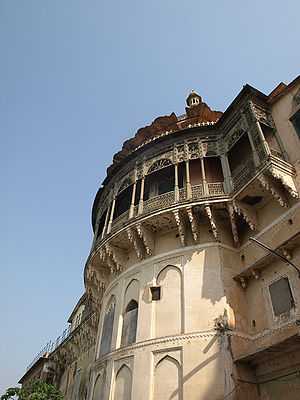Ramnagar, Varanasi
| Ramnagar, Varanasi Ramnagar | |
|---|---|
| city | |
 Ramnagar, Varanasi Location in Uttar Pradesh, India | |
| Coordinates: 25°17′N 83°02′E / 25.28°N 83.03°ECoordinates: 25°17′N 83°02′E / 25.28°N 83.03°E | |
| Country |
|
| State | Uttar Pradesh |
| District | Varanasi |
| Elevation | 64 m (210 ft) |
| Population (2001)[1] | |
| • Total | 39,941 |
| Languages | |
| • Official | Hindi |
| Time zone | IST (UTC+5:30) |
Ramnagar is a city and a municipal board in Varanasi district in the Indian state of Uttar Pradesh. Ramnagar has a fort known as Ramnagar Fort which is still the residence of King of Varanasi (Benares). He was known as Kashi Naresh meaning king of Kashi (Ancient name of Beneras) and is still regarded by old residents of the city of Varanasi. Ramnagar Fort and its museum are the repository of the history of the kings of Benares and since the 18th century has been the home of Kashi Naresh.[2] Even today the Kashi Naresh is deeply revered by the people of Benares.[2] He is the religious head and the people of Benares consider him the incarnation of Lord Shiva.[2] He is also the chief cultural patron and an essential part of all religious celebrations.[2] Ramnagar is popular for Ramlila that is held annually under the aegis of King of Varanasi [3]
Recently Ramnagar has emerged as a favorite spot for shooting movies because of the scenic location of the Ramnagar Fort (residence of the King of Varanasi) near the Ganges. Chokher Bali is one of the popular movies shot here.
History
The Ramnagar Fort was built by Kashi Naresh Raja Balwant Singh with creamy chunar sandstone in the eighteenth century.[2] It is a typically Mughal style of architecture with carved balconies, open courtyards, and picturesque pavilions.[2]
Saraswati Bhawan , Ramnagar Fort

A rare collection of manuscripts, especially religious writings, is housed in Saraswati Bhawan. It includes a precious handwritten manuscript by Goswami Tulsidas.[2] There are also many books illustrated in the Mughal miniature style, with beautifully designed covers.[2]
Vyasa Temple at Ramnagar
According to a popular Puranic story, when Vyasa failed to get alms in Varanasi he put a curse on the city.[2] Soon after, at a house where Parvati and Shiva had taken human form as householders, Vyasa was so pleased with the alms he received that he forgot his curse.[2] However, because of his bad temper Shiva banished Vyasa from Varanasi.[2] Resolved to be near at hand, Vyasa took his residence on the other side of the Ganges where his temple may still be seen at Ramnagar.[2]
Ramlila
When the Dussehra festivities are inaugurated with a colourful pageant Kashi Naresh rides an elephant at the head of the procession.[2] Then, resplendent in silk and brocade, he inaugurates the month-long folk theatre of Ramlila at Ramnagar.[2]
The Ramlila is a cycle of plays which recounts the epic story of Lord Rama, as told in Ramcharitmanas, the version of the Ramayana penned by Tulsidas.[2] The plays sponsored by the Maharaja, are performed in Ramnagar every evening for 31 days.[2] On the last day the festivities reach a crescendo as Rama vanquishes the demon king Ravana.[2] Maharaja Udit Narayan Singh started this tradition of staging the Ramleela at Ramnagar in mid-nineteenth century.[2] Over a million pilgrims arrive annually for the vast processions and performances organized by Kashi Naresh. The Ramlila of Ramnagar basically operated by Maharaja of Banaras with the help of Pt. Laxmi Narayan Pandey and his cultural family every year. [4]
Demographics
As of 2001 India census,[5] Ramnagar had a population of 39,941. Males constitute 54% of the population and females 46%. Ramnagar has an average literacy rate of 58%, lower than the national average of 59.5%: male literacy is 66%, and female literacy is 49%. In Ramnagar, 15% of the population is under 6 years of age.
References
- ↑ "Census of India 2001: Data from the 2001 Census, including cities, villages and towns (Provisional)". Census Commission of India. Archived from the original on 2004-06-16. Retrieved 2008-11-01.
- ↑ 2.0 2.1 2.2 2.3 2.4 2.5 2.6 2.7 2.8 2.9 2.10 2.11 2.12 2.13 2.14 2.15 2.16 2.17 Mitra, Swati (2002). Good Earth Varanasi city guide. Eicher Goodearth Limited. p. 216. ISBN 978-81-87780-04-5.
- ↑ Ramlila of Varanasi bharatonline.com.
- ↑ Banham, Martin (1995). The Cambridge Guide to Theatre (2nd ed.). Cambridge University Press. p. 1247. ISBN 978-0-521-43437-9.
- ↑ "Census of India 2001: Data from the 2001 Census, including cities, villages and towns (Provisional)". Census Commission of India. Archived from the original on 2004-06-16. Retrieved 2008-11-01.
External links
| ||||||||||